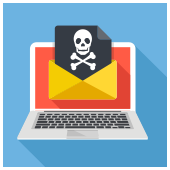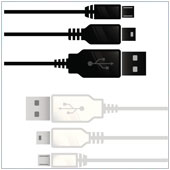
As more and more businesses move their operations online, the need for robust cybersecurity measures has never been greater. However, many employees are still unfamiliar with many cybersecurity terms. Here are some of the most commonly used terms in IT security. By understanding these terms, you will be better equipped to protect your business from cyberattacks.
Malware
For a long time, the phrase “computer virus” was misused to refer to any type of attack that harmed computers and networks. The more appropriate term for these harmful programs and files is “malicious software,” or “malware.” Whereas a virus is a specific type of malware designed to replicate itself, any software created for the purpose of destroying or accessing networks and data with the intent to steal, corrupt, or encrypt these should be referred to as malware.
Ransomware
Don’t let all other cyberthreats ending in “-ware” confuse you; they are all just subcategories of malware. Currently, one of the most notorious of these is ransomware, which is malware that encrypts valuable data until a ransom is paid for the decryption key. In a ransomware attack, the victim organization may feel compelled to pay the ransom to regain access to their data.
Intrusion prevention system (IPS)
There are several ways to safeguard your network from malware, but an IPS is one of the nonnegotiables. An IPS sits behind your company’s firewall and monitors for suspicious and malicious activity that can be halted before it can exploit or take advantage of a known vulnerability.
Social engineering
Not all types of malware rely solely on fancy computer programming. Experts agree that the majority of attacks require some form of social engineering to succeed. Social engineering is the act of tricking people, rather than computers, into revealing sensitive or protected information. For some cybercriminals, it’s less tedious to convince a potential victim to give them the data they need than to create and deploy complicated software to obtain the same information.
Phishing
Phishing is a type of social engineering scheme that involves defrauding people using an app or a website that impersonates a trustworthy or often well-known business in an attempt to obtain confidential information. Just because you received an email that says it’s from the IRS doesn’t mean that it is. Don’t take such emails at face value — always verify the source, especially if the emails are requesting your sensitive data.
Antivirus
Antivirus software is often misunderstood as a way to comprehensively secure your computers and workstations. These applications are just one piece of the cybersecurity puzzle and can only scan the drives on which they are installed for signs of well-known malware variants.
Zero-day attacks
When a vulnerability is found within a piece of software, vendors will release an update to fix the gap in security. However, cyberattackers can release a piece of malware that exploits the security vulnerability before software developers can address it. This is known as a zero-day attack.
Patch
When software developers discover a security vulnerability in their programming, they usually release a small file to update and “patch” this gap. Patches are essential to keeping your network secure from the vultures lurking on the internet. By checking for and installing patches as soon as these become available, you keep your software protected from the latest malware.
Redundant data
When antivirus software, patches, and intrusion prevention fail to keep your information secure, there’s only one thing that will: quarantined off-site storage. Duplicating your data offline and storing it somewhere other than your business’s workspace ensures that even if your systems get infected with malware, you’re equipped with backups to keep your business running.
Our cybersecurity professionals are always available to impart more in-depth knowledge of the many different kinds of cyberthreats. Get in touch with us today and find out how we can help you with your IT security woes.



 Many businesses use email to send and receive sensitive information, making it an attractive target for cyberattacks. To reduce your exposure to cyberthreats, implement the following email security measures.
Many businesses use email to send and receive sensitive information, making it an attractive target for cyberattacks. To reduce your exposure to cyberthreats, implement the following email security measures. There are millions of malware in existence, with new ones being developed by the minute. This is terrible news for anyone who stores personal information online — which is basically everyone in the world today. Learn how you can avoid being a victim of a watering hole attack, one of the most common ways cybercriminals introduce malware into networks.
There are millions of malware in existence, with new ones being developed by the minute. This is terrible news for anyone who stores personal information online — which is basically everyone in the world today. Learn how you can avoid being a victim of a watering hole attack, one of the most common ways cybercriminals introduce malware into networks. Cybersecurity is a constant battle, but there are significant steps you can take to keep your IT defenses strong and effective, one of which is to increase your knowledge of security threats. Here are five common ways your business systems can be infiltrated.
Cybersecurity is a constant battle, but there are significant steps you can take to keep your IT defenses strong and effective, one of which is to increase your knowledge of security threats. Here are five common ways your business systems can be infiltrated. There are several ransomware decryptors now, thanks to communities of white hat hackers concerned about increasing ransomware attacks worldwide. While some of these decryptors do come with a price, the rest are free or can be availed for a minimum donation.
There are several ransomware decryptors now, thanks to communities of white hat hackers concerned about increasing ransomware attacks worldwide. While some of these decryptors do come with a price, the rest are free or can be availed for a minimum donation. Are your organization’s cyber defenses enough to protect it from a cyberattack? Unfortunately, just incorporating the latest antimalware software or firewall to your system won’t guarantee your company’s safety. Conducting a security audit will give you a complete picture of your company’s data integrity, giving you a greater chance of successfully meeting your cybersecurity goals.
Are your organization’s cyber defenses enough to protect it from a cyberattack? Unfortunately, just incorporating the latest antimalware software or firewall to your system won’t guarantee your company’s safety. Conducting a security audit will give you a complete picture of your company’s data integrity, giving you a greater chance of successfully meeting your cybersecurity goals. Smartphones have become a vital part of modern life. And as we spend more time on these gadgets, the likelihood of needing to recharge them while on the go increases. When your phone’s juice runs out and you’re nowhere near your charger, a public charging kiosk can look pretty promising. But what you might not know is that recharging phones at public charging stations can make you a victim of juice jacking.
Smartphones have become a vital part of modern life. And as we spend more time on these gadgets, the likelihood of needing to recharge them while on the go increases. When your phone’s juice runs out and you’re nowhere near your charger, a public charging kiosk can look pretty promising. But what you might not know is that recharging phones at public charging stations can make you a victim of juice jacking. Every business should have a strong cybersecurity posture to keep cybercriminals from infiltrating their network. One way to do this is by implementing a strict authentication process using two-step or two-factor authentication. These two processes are so similar that many confuse one with the other. Learn the difference between the two and how you can leverage them to safeguard your network.
Every business should have a strong cybersecurity posture to keep cybercriminals from infiltrating their network. One way to do this is by implementing a strict authentication process using two-step or two-factor authentication. These two processes are so similar that many confuse one with the other. Learn the difference between the two and how you can leverage them to safeguard your network.